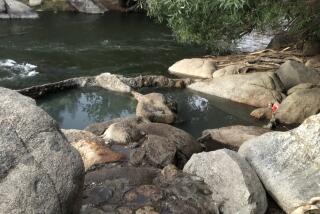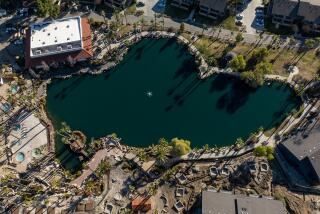PBS ‘Discoveries’ Series Dives for Sunken Treasures
- Share via
Every time Wilburn (Sonny) Cockrell goes to work, he plunges 230 feet into a Florida sinkhole and 12,000 years into the past.
Cockrell is an underwater archeologist who is harvesting relics from the Pleistocene Epoch, some of them human, from the depths of Warm Mineral Springs, the spa that bills itself as Ponce de Leon’s “fountain of youth.”
Cockrell’s work as director of the University of Florida research project is examined in an episode of PBS’ “Discoveries Underwater,” airing Monday. The eight-part documentary series from KCET-TV Los Angeles and the BBC looks at shipwrecks, sunken treasures and the lost city of Atlantis.
The age of the bones in the Warm Mineral Springs sinkhole has been established by carbon dating at about 12,000 years.
“I feel early man used this place to dispose of the dead,” said Cockrell, a tall man with thick sandy hair and a big beard starting to show gray. “We’ve found the remains of more than 20 men so far. We’ve also found the bones of a giant ground sloth, a saber-toothed cat, a North American horse and a type of camel related to the llama.
“The climate was much cooler then. There were no palm trees and very few pines. We’ve found trees down there, some nuts and pollen. What we’re trying to do is understand the humans against this background.”
The human remains are Paleo-Indians. Based on their skeletons, they averaged about 5-foot-4 and 110 pounds. Cockrell said the skulls resemble those found in a cave in China more than those of southeastern Indians.
The bones have been preserved because the water in the sinkhole has no oxygen. It is also very warm and has a high mineral content, thus attracting many people to it for bathing, despite the sulfurous smell.
Cockrell has also pulled up relics from more recent times, including Coca-Cola bottles and a deer skull.
“My principal interest as an underwater archeologist is looking for sites from the ice age that are now underwater,” Cockrell said. “Since the ice caps melted, the ocean level has risen 300 feet worldwide. We were looking in the wrong places to find early man. We should be looking for those sites that are now up to 300 feet beneath the ocean.
“This sinkhole was once a cave that collapsed about 30,000 years ago. Things have been falling into it since then. We’re digging through many generations.”
Diving to the bottom of the hole, 230 feet down at its deepest, is dangerous and scary. It is pitch black at the bottom. It takes 93 minutes to decompress on the way up.
Before coming to Warm Mineral Springs, Cockrell was Florida’s underwater archeologist. That was a job that put him in daily contact with underwater treasure salvagers, including Mel Fisher, who found the multimillion-dollar wreck of the Atocha.
Not all salvagers are legitimate, Cockrell said.
“Most of the money in finding sunken treasure is made on dry land by people selling shares in shady salvage schemes,” he said. “There are also a lot of phony treasure maps for sale. We even found one that was copied from the place mat at a fast food restaurant. Some people are making big money selling cheap dental gold in bars to look like Spanish gold.”
More to Read
Sign up for Essential California
The most important California stories and recommendations in your inbox every morning.
You may occasionally receive promotional content from the Los Angeles Times.













